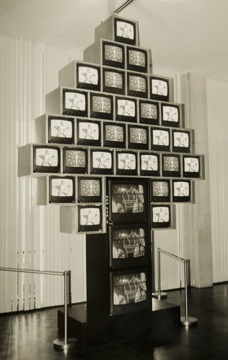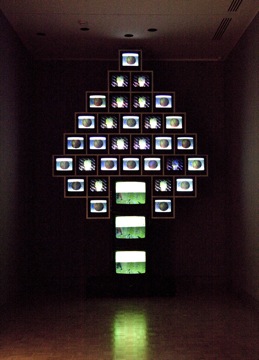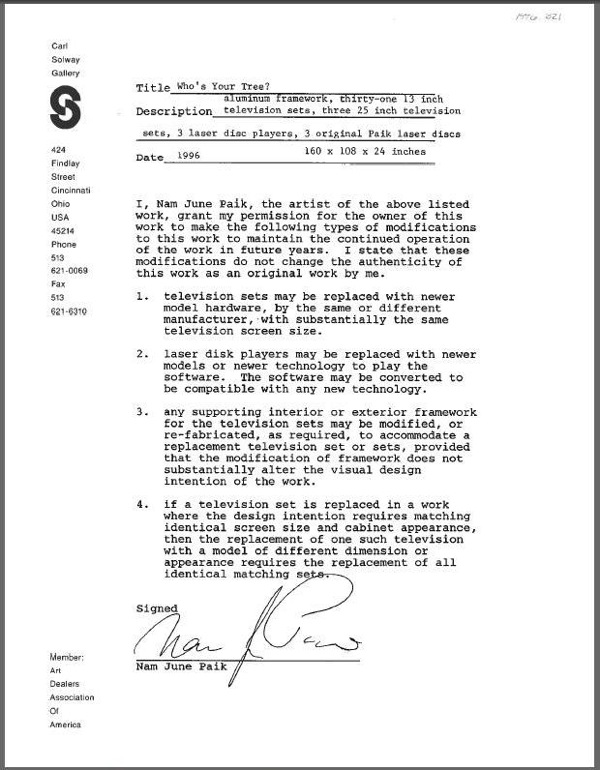Spearheaded by Richard McCoy, a conservator at the Indianapolis Museum of Art, this site’s newest column, “No Preservatives,” seeks to define the conservator’s role in the conservation of art in the twenty-first century. Every third Tuesday of the month, McCoy will discuss current issues, approaches, and decisions surrounding contemporary conservation projects at the IMA and a host of other institutions.

Nam June Paik, "Who's your Tree," 1996. Installation view at the Indianapolis Museum of Art, 1997. Accession number = 1996.321. Now and Future Purchase Fund and Robert and Ina Mohlman Art Fund. The Estate of Nam June Paik.
Last April, I heard the former US Poet Laureate, Charles Simic, give a reading at Butler University. Since then I’ve been thinking a lot about the poem “The Clocks of the Dead.” Simic introduced this poem by telling a story about how analogue clocks used to be everywhere in his house but, as we all know, by the mid-1990s many of these clocks had gone digital and, for the most part, silent. For better or worse, the domestic audiological landscape changed in a matter of a few years.
Sure, this poem could be read as a meditation on remembrance of lost loved, but there are a few lines that I think operate to produce a metaphor for some of my work as an art conservator at the Indianapolis Museum of Art .
Once there were clocks like that
In every kitchen in America.
Now the factory’s windows are all broken.
The old men on night shift are in Charon’s boat.
The day you stop, I said to the clock,
The little wheels they keep in reserve
Will have rolled away
Into many hard-to-find places.
Though I feel a little guilty excerpting just this part of the poem to make my point, I do it because some days it seems like part of my job is to examine contemporary artworks and identify the “wheels” to the “clocks” that have stopped, or work to try understand which parts of the clock will most likely stop in the near future. And due to the increasing speed of technological advances and the variety of components used in the creation of contemporary artworks, much of the time it seems like these wheels are rolling away beyond my reach at an increasing speed.
As an art conservator, I value art for what it represents and how it’s represented when on display. I value art so much that I’m working to help keep it viable now and in the future; that is, when it is designed to be kept around for that long. But that’s a whole different post.
Today, I believe the value of art is directly tied to the notion of authenticity of representation. By this I mean the accuracy of representation of an artist’s idea(s). As can be seen in the following example of Nam June Paik’s Who’s Your Tree, even when guidelines are established as to how an artwork can change over time, the concept of authenticity and correct representation is still complicated and open to some level of interpretation.
Some artists have anticipated this issue and have put guidelines in place that will describe how their works can evolve alongside technological advancements. Many art conservators have begun working within interdepartmental teams to prepare for the transition and migration of components of artworks. At the IMA, we created the “Variable Art Team” to discuss and strategize ways to ensure artworks are well-documented and ultimately represented authentically when on view. Our team is led by the conservation and curatorial departments, but has members from nearly ever department playing key roles.
One of our upcoming projects for this year is to find 34 replacement televisions for a work commissioned by IMA in 1996 by Nam June Paik. Who’s Your Tree originally consisted of 31 13” CRT televisions and 3 25” CRT televisions, three laser disc players, and the corresponding three laser discs. While you can’t see it in the image at the top of this post, this 1997 installation view shows the artwork exhibited with the 3 laser disc players (they machines are encased inside the black aluminum base). It also shows metal stanchions that are not part of the work and are no longer used in its current installation.

Nam June Paik, "Who's Your Tree," 1996. Installation view at the Indianapolis Museum of Art, 2009. Accession number = 1996.321. Now and Future Purchase Fund and Robert and Ina Mohlman Art Fund. The Estate of Nam June Paik.
This is how the artwork looks in the gallery today. The images on the televisions are no longer produced by laser disc players, but by 3 DVD players. The 3 video files were migrated from laser disc to DVD in the early 2000s with consent and guidance from the artist’s letter below. Of course, we are storing the original laser discs and players.

Signed document by Nam June Paik from the IMA's Historical Files
The above document, signed by Paik, was used to guide the IMA in the migration of the media used in this artwork. Clearly, Paik had a concept of how his artwork could continue to be correctly represented over time and in parallel with existing and emerging technologies.
But do you think that Paik envisioned that nearly all television monitors would dramatically change format as rapidly as they have in the past 3-5 years? The CRT television is quickly becoming as obsolete as flat-screen; wide format televisions have become the standard in new televisions in the U.S. Today, it’s hard to even find places that sell CRT televisions. In a matter of a few years, CRT televisions will become as obsolete as laser disc players are today.
This summer, we are hoping to buy a complete back-up set of televisions for this piece and put them in storage (yes, that’s a total of 34 televisions that we want to put into art storage). However, given Paik’s document I would also feel comfortable replacing them with flat screen televisions of the same dimension and aspect ratio. But I wouldn’t be willing to replace them with widescreen televisions, as this would not be “substantially the same television screen size.” In short, we recognize that by simply buying one new set of televisions, we’re not guaranteeing that the artwork will be around “forever.” But we’re at least buying a lot more time.
The path remains clear as to how we can continue to represent Paik’s artwork authentically, but no doubt there are technological changes ahead that we haven’t even begun to anticipate. In the end, the day may come when we load Charon’s boat with artworks that are no longer possible to represent, but not today.
Richard McCoy is Assistant Conservator of Objects at the Indianapolis Museum of Art, where he conserves artworks across all areas of the collection. McCoy’s research extends beyond the technology and structure of artworks to include artistic intent and execution as it relates to the preservation of contemporary art.



Pingback: Fridays Links Roundup : Bad at Sports
Pingback: What is the value of art? | Art21 Magazine